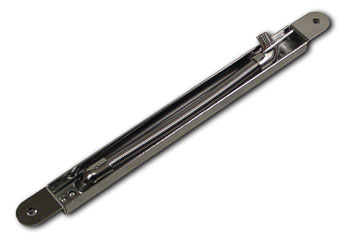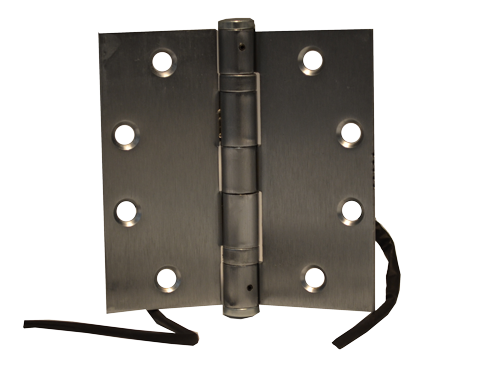When installing electrified door hardware, one important consideration is how to get low-voltage power from the wall into the door. There are a few common methods—each with its own advantages, limitations, and best-use scenarios. The three most common are:
- Power transfers
- External flex conduit (door loops)
- Electric hinges (including continuous hinges)
Power Transfers

A power transfer provides a hidden channel for wiring through flex conduit built into a pocket on the hinge side of the door. This method keeps wires protected and supports larger gauge wires for hardware that requires higher current or amperage.
Because power transfers must be built into the door and frame, they’re best considered during the initial design and ordering stage. They are not easily retrofitted, so planning ahead is key.
External Flex Conduit (Door Loops)

Flex conduit—commonly known as a door loop—is the most widely used method. It’s inexpensive, easy to install, and widely available.
That said, door loops have some drawbacks. Exposed flex conduit can be vandalized, and on high-traffic doors, the loop itself can pose a catch hazard. Concealed flex conduit kits are becoming more common, and depending on the wall and door construction, these can be a smart retrofit solution.
Electric Hinges

Electric hinges provide a concealed and vandal-resistant option for transferring wires. In many cases, they can be retrofitted into existing door applications, provided the wall construction and hinge patterns allow.
These hinges are typically available with 4–12 wires. However, they use smaller diameter wire, which can limit their ability to power devices with higher amperage needs. To work around this, some installers will “double up” wires—using more than one conductor for each side of the current.
Because the wiring passes through the hinge itself, the wires flex as the door opens and closes, and over time they may break. Fortunately, most manufacturers include extra wires, allowing installers to switch connections if needed.
Electric hinges are a great fit when you need concealed power transfer, concealed monitoring, or both.
Electric Continuous Hinges
Electric continuous hinges are a cost-effective alternative to custom hinges and offer several long-term benefits. Because they run the full length of the door, they distribute pressure evenly, reducing wear and tear.
Other advantages include:
- Quieter operation
- Increased door life span
- Easier installation compared to some custom hinge options
Continuous hinges are a strong choice when you want durability and longevity in addition to concealed power transfer.
Choosing the Right Option
Each of these methods can be the right solution depending on your project. The best choice often depends on factors like security requirements, door usage, amperage needs, and whether you’re planning ahead or retrofitting.
By understanding the strengths and limitations of each method, you’ll be better prepared to specify the right option for your security door hardware installation.
| Method | Pros | Cons | Best For |
|---|---|---|---|
| Power Transfers (EPT/PT) | -Concealed and secure wiring -Supports larger gauge wires for high-current hardware -Protects wiring from wear | -Must be planned during design phase -Difficult to retrofit | New construction or planned installs requiring higher amperage |
| External Flex Conduit (Door Loop) | -Least expensive -Easiest to install -Widely available | -Exposed conduit can be vandalized -Can be a catch hazard on high-use doors -Less aesthetically pleasing | Budget-friendly installs, Simple retrofits |
| Concealed Flex Conduit Kits | -Hidden from view -Retrofit friendly, depending on wall construction | -Limited by wall/door conditions -More labor than exposed flex conduit | Retrofitting when aesthetics and vandal resistance are priorities |
| Electric Hinges | -Concealed and vandal-resistant -Retrofit possible, depending on hinge pattern and wall construction -Usually available with 4-12 wires -Supports monitoring options | -Limited by wire gauge (lower current capacity) -Wires can eventually flex and break -Higher cost than door loop | Doors needing concealed wiring and monitoring without major redesign |
| Electric Continuous Hinges | -Cost-effective compared to custom hinges -Full door length = reduced wear and tear -Quieter operation -Easy to install | -Bulkier look than standard hinges -May be unnecessary for lighter-use doors | Heavy-use doors in schools and hospitals, or doors needing long-term durability |








